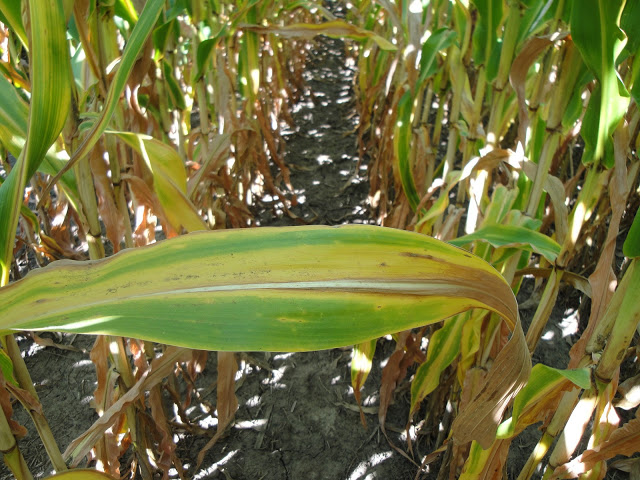September 3, 2019

By: Brad Carlson, Extension educator
If you’ve seen nitrogen (N) deficiency symptoms in corn popping up in fields across Minnesota, you’re not alone. Crops in the past couple weeks have begun to show substantial N deficiency symptoms around the R3-R4 stages.
Challenging conditions during planting season led to less than ideal seedbeds, with compacted areas in many fields affecting crop rooting. Additionally, a widespread issue this year is compaction caused by manure applications when fields were too wet. In some locations, there was a lot of moisture early in the season that may have prevented deep rooting, and potentially led to N loss through denitrification. One final factor is that plants now have a big sink – the cob – causing N to mobilize within the plant.
Between fertilizer and mineralization, the corn plant will have enough N to stay green under normal conditions. This makes it hard to detect deficiency either visually or with sensors, especially early in the season when corn does not need a lot of N. As the season progresses, plants need more N as they accumulate dry matter in the grain. Given this year’s circumstances, there are many situations where the need has surpassed the supply. When these conditions develop this late in the season, it is too late to correct the problem. Additionally, many of the fields showing N deficiency symptoms have enough N, but the plants’ inadequate root systems are unable to reach it.
Currently, the plant is translocating N from vegetative tissues to the grain. If the entire plant is staying green, it’s a good indication that you applied excessive N. It is normal for the lower leaves to turn yellow and fall off, but if this extends all the way to the ear, you will likely see a reduction in yield. Areas where the whole plant is yellowing correspond to severe N deficiency. Many of these spots are the result of poor drainage, meaning not much could have been done in terms of N management to prevent it. Make sure you don’t confuse N deficiency, which will manifest itself from the ground up, with leaf diseases or other nutrient deficiencies (like sulfur), which frequently occur toward the top of the plant.
Can I do anything about late-season N deficiency?
At this point, do not add N. Research has shown that it is too late in the season to impact yield. The soil will, however, continue to mineralize N as long as there are warm temperatures and adequate soil moisture. Where there are poor root systems, regular rain will provide a supply of N to the grain. If you are concerned about the N status of your crop, you can use the basal stalk nitrate test. While this test does not tell you what the right amount of N fertilizer should have been, it will tell you, approximately, whether the crop had adequate, deficient, or excessive amounts of N.
Source: University of Minnesota Extension
The source is solely responsible for the information provided and is wholly owned by the source. Informa Business Media and all its subsidiaries are not responsible for any of the content contained in this information asset.
You May Also Like




